Is the hard wired and the blue tooth edition of EZ App built to NMRA standards?
- Welcome to Bachmann Online Forum.
News:
Please read the Forum Code of Conduct >>Click Here <<
This section allows you to view all posts made by this member. Note that you can only see posts made in areas you currently have access to.
Pages1
#2
General Discussion / Periodes of service
January 23, 2017, 10:20:42 PM
I noticed (jn the 2016 catalog) that Bachmann has addressed many different historical periods in history. there are Older steam engine with what I assume are appropriate rolling stock, the following generations of steam, the "Prairie, Mikados, Challengers, Big Boys etc. all with time period appropriate rolling stock.
I was hoping to find appropriate rolling stock for my Milwaukee, Chicago & Puget Sound (later changer to Chicago, Milwaukee & Pacific) Rail Road. The MC & PS operated in the first 12 years or so of the 20th century. I would also like to have cars and engines appropriate to the years after it became the Chicago, Milwaukee & Pacific.
Now I figure the rolling stock such as box cars, refrigerater cars and cabooses were on frames of steel and the super structures were made of wood. Tank cars and grain, coal, as such....I don't know for sure but I assume they were steel.
Having said all that...
Does Bachmann have rolling stock identifiable as being correct for my road in my periods in history? Is there a reason I do not see periods of use listed with the cars in the catalogs?
I have researched the internet and found some great sites (http://www.craigmagnuson.com/laconia1.htm) and (https://www.mrha.com) and will more closely check them out, in the mean time can anyone give me some pictures or examples of the rolling stock I need?
Yes, I am new to the hobby!
Thanks!
I was hoping to find appropriate rolling stock for my Milwaukee, Chicago & Puget Sound (later changer to Chicago, Milwaukee & Pacific) Rail Road. The MC & PS operated in the first 12 years or so of the 20th century. I would also like to have cars and engines appropriate to the years after it became the Chicago, Milwaukee & Pacific.
Now I figure the rolling stock such as box cars, refrigerater cars and cabooses were on frames of steel and the super structures were made of wood. Tank cars and grain, coal, as such....I don't know for sure but I assume they were steel.
Having said all that...
Does Bachmann have rolling stock identifiable as being correct for my road in my periods in history? Is there a reason I do not see periods of use listed with the cars in the catalogs?
I have researched the internet and found some great sites (http://www.craigmagnuson.com/laconia1.htm) and (https://www.mrha.com) and will more closely check them out, in the mean time can anyone give me some pictures or examples of the rolling stock I need?
Yes, I am new to the hobby!
Thanks!
#3
N / Re: N-Gauge: new to this forum and new to N-gauge...
January 12, 2017, 12:32:38 AM
I too am new to both the hobby and the forum; I can tell you that so far I have been welcome in a fine manner! I have 2 responses to my 3 or 4 posts (lengthy as they are) and have gained some recommendations and good advice.
I'm thinking your track will do better once it's fastened down to the table top, the electrical connectors at the track ends probably came loose with all the action (running trains and such. Why the loco gave up the ghost is beyond me; I know a little bit about motors and hope to learn a lot more here on this forum!
Bachmann has been around a LONG time and I'm sure they will help get the kinks worked out, the existence of this forum is proof positive they care about what happens after the sale.
I am told Bachmann has 3 lines of trains, I don't know if that means they make 3 grades of trains in each scale they offer or the 3 are each in a different scale.
The major thing is let's have some FUN and relax pursuing our new hobby, let's learn and teach each other what we know to further our enjoyment while we relentlessly go for it!
I'm thinking your track will do better once it's fastened down to the table top, the electrical connectors at the track ends probably came loose with all the action (running trains and such. Why the loco gave up the ghost is beyond me; I know a little bit about motors and hope to learn a lot more here on this forum!
Bachmann has been around a LONG time and I'm sure they will help get the kinks worked out, the existence of this forum is proof positive they care about what happens after the sale.
I am told Bachmann has 3 lines of trains, I don't know if that means they make 3 grades of trains in each scale they offer or the 3 are each in a different scale.
The major thing is let's have some FUN and relax pursuing our new hobby, let's learn and teach each other what we know to further our enjoyment while we relentlessly go for it!
#4
N / Re: New guy with spec questions.
January 12, 2017, 12:11:29 AMQuote from: brokemoto on January 11, 2017, 09:40:35 AM
I tried to look at larger versions of the photographs that you posted, but got only the perpetual loading. I suspect it is more a problem on my end than it is on yours.
Still.
You might want to make a careful cut and then cover job on the tunnels so that you can have access to the track under them. If you fail to do that, you may rest assured that most of your problems will occur on the tracks in the tunnels, especially dirty track and massive derailments. Murphy loves model railroading. His law seems to go double when it is time to operate the railroad.
I can get to the tracks in the tunnels for most of the tunnel length, ONE tunnel is completely enclosed, THAT tunnel may be accessible though a hole in the table? I don't know yet; you're suggestion of some judicious sawing may be the best solution. Time will reveal all.
In most cases, the One Ampere output of most DC power supplies is sufficient.
You may have to add booster wiring if the original owner did not. The MRC dual pack is a good one. I use them. They last forever. I have one that is almost twenty five years old. Mine is a 2800. The slow speed control should be very good for most locomotives if you are using this power supply.
What is "Booster wiring"?
If your wife acquired this from an older gentleman, I wonder how much he operated it in the last few years. What you might have to do is put the locomotives on the track and run them around it several times in both directions. If you can pop off or unscrew the shells, you might take a Q-tip and put a little seventy per-cent or a little Life Like track cleaner onto the armature of the motor. I have made balky locomotives that have been sitting for some time run just as they were supposed to run by doing this.
I have been "exercising" the engines in just the way you describe, I have had some results but a little 3'N1 oil sure made the bigger difference, but a good cleaning and the correct lube will probably do the trick.
Your poor slow speed control may have its roots in the locomotives themselves. How old are they and who manufactured them? Much power manufactured during the early 1980s or before does not run well as it is. Often they have only two speeds: very fast and not-at-all. Some do have three: Very fast, still too fast and not at all. Examples of this are Mehano (two speeds) or Roco (three speeds). There is also some power that has decent slow speed control--when it actually will run. These locomotives are finicky and will stall on less than professional grade track work. Atlas/Kato power are examples of this.
I have no idea of how I could date the locos (all 3 are Bachmann models)on my own. Possible here with pics...I also have a Lionel "Super Chief" Style (cab WAY up front, a divided windshield tilted back, head light below and centered on the split windshield) loco in n gauge that won't even run on the track because (I think) the square shaped on the bottom are to low and rub on the ties. I think maybe this loco is meant for taller track...so it's available if any one in interested!
I believe the locos (again all 3 are Bachmann models) are newer than the '80's but I don't KNOW.
For most of these, there is little, if anything to be done to improve them. You can hard wire the Atlas/Katos in pairs. That will eliminate the stalling problem.
The best of that era are the Con-Cor/Kato offerings: the PAs, E-units and the Hudson.
If the thing is only two feet wide, the best curve radius on it is eleven, or so, inches. That falls into the "sharp" category. ("Conventional" is thirteen inches, "broad" is sixteen or better----I am scaling down the old HO categories and measurements, here). Some of the curves are even more sharp than eleven inches. Pretty much anything larger than a 2-8-0 is not going to run on an eleven inch curve, and, if it will, it will look pretty silly. I can run the LL/Walthers 2-8-4 around an eleven inch curve, but it looks really silly on it. It looks silly even on a thirteen inch curve. On the nine inch curves, you will have a hard time with anything larger than a 4-6-0. Even if something larger will run on the nine inch curves, it does look pretty silly doing so.
On the eleven inch curves, you pretty much are limited to four axle diesels and steam locomotives 2-8-0 or smaller. Some six axle diesels will run on the sharp curves, but will not look their best doing so. Further, there is a tendency these days to body mounted couplers on rolling stock. Longer power and rolling stock, especially with body mounted couplers, can cause derailments on sharp curves. You might want to keep the rolling stock to sixty five feet or less.
Good advice!
Some of the wires may have come disconnected during the move. I moved my pike four times before I finally took it down and re-worked it. Every time that it moved, there were more than a few wires that came undone. Have a volt meter to test continuity and to see where there are voltage drops. You can buy inexpensive volt meters in many places. Check Micro Mark's website. The volt meter will tell you where you need booster wires. Life-Like used to sell a continuity tester that is two wires and a light bulb. If the light lit, you were in good shape. If it did not, you had a problem. I still see them at shows and at some hobby stores. The volt meter is the better buy, though, as it tests continuity and voltage at the same time. If the needle moves (or the numbers light), you have a good circuit. If the needle does not move, you have a problem. If the needle pegs too fast or too high, though, you may have a short.
I have a digital VOM, I appreciate the trouble shooting advice! Under the pull out drawer lies all the bundled up wiring for the switches, it's covered with a piece of THIN something or other. I will eventually have to get in there and see what I can find. I hope to get a local modeler out to my home for some assistance.
The pike looks like a pretty good one, it might just need the power and rolling stock that fits it. The MRC power supplies are good. Keep the track clean and do something about the tunnel access and you should be all right.
Thanks again for your kind analysis and advice!
#5
N / Re: New guy with spec questions.
January 11, 2017, 11:51:29 PMQuote from: Flare on January 11, 2017, 12:31:04 AM
Nice pics.
Aside from noise, are the trains performing any better now? (I forgot to mention that the locomotive's wheels and electrical contacts should be cleaned too. Woodland Scenics makes a tool which makes cleaning the wheels really easy: http://woodlandscenics.woodlandscenics.com/show/Item/TT4560/page/1 )
Most of the longer steamers have a curve radius limit. Sorry to hear yours exceeds the layout.
The noise is much better with a TINY bit of 3'n1 oil on the INSIDES of the rails in the turn outs. I cleaned the wheels with contact cleaner and a cotton swab, I rotated the wheels using the power on the track and just kept swabbing the wheels till the entire circumference had been cleaned. Only 1 tunnel is hard to get too; underneath the table access to the tunnels can be gained at he apex of the turn in the tunnel for almost half the distance through the tunnels. The larger Loco may require a new road or can be used as a swapping resource!
#6
N / Re: New guy with spec questions.
January 10, 2017, 11:12:00 PM
Here is the panoramic view of the set up in my house. left to right.
The back drop in the as bought pic came with it, I was told a local artist did it; it matches up to the layout, down on the l/h end is Mt Rainier, I live about 80 miles from the Mountain and I can see it, all 14,000 feet!
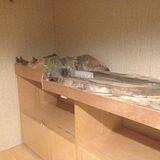
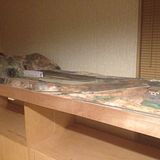
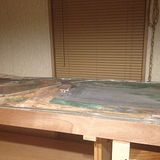
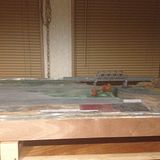
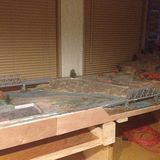
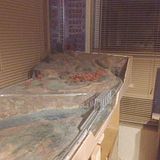
I got a whole bunch of scenic stuff and rolling stock besides the 3 locos, the steam is too long for this road so GEE; I guess I'll have to build a prairie road to connect to this road! Oh the HUMANITY!!!
The back drop in the as bought pic came with it, I was told a local artist did it; it matches up to the layout, down on the l/h end is Mt Rainier, I live about 80 miles from the Mountain and I can see it, all 14,000 feet!






I got a whole bunch of scenic stuff and rolling stock besides the 3 locos, the steam is too long for this road so GEE; I guess I'll have to build a prairie road to connect to this road! Oh the HUMANITY!!!
#7
N / Re: New guy with spec questions.
January 10, 2017, 11:08:01 PM
I cleaned as much of the track as I could reach (yep the tunnels are NOT removable) using a gun cleaning patch and electrical contact cleaner, yep; the tracks were filthy and some spots has some ballast glue on them. I plan on getting one of those track cleaning cars as soon as I could get a recommendation....  Now what about a LITTLE oil in the guides (frogs?) of the turn outs... seems my locos slow down in there on a turn... I know it will somewhat as the loco is changing direction. I tried a LITTLE 3 'n one oil in there (it was the lightest oil I have) and wiped the top of the tracks off after applying the lube, the transit was more quiet than before.
Now what about a LITTLE oil in the guides (frogs?) of the turn outs... seems my locos slow down in there on a turn... I know it will somewhat as the loco is changing direction. I tried a LITTLE 3 'n one oil in there (it was the lightest oil I have) and wiped the top of the tracks off after applying the lube, the transit was more quiet than before.
Overall as purchased
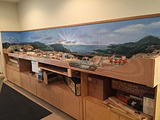
Overhead left to right.


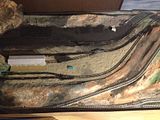
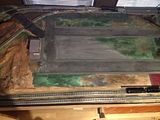
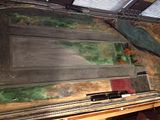
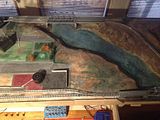

5 tunnels on the left end and 1 on the right end. 9 turn outs and 2 river crossings.
 Now what about a LITTLE oil in the guides (frogs?) of the turn outs... seems my locos slow down in there on a turn... I know it will somewhat as the loco is changing direction. I tried a LITTLE 3 'n one oil in there (it was the lightest oil I have) and wiped the top of the tracks off after applying the lube, the transit was more quiet than before.
Now what about a LITTLE oil in the guides (frogs?) of the turn outs... seems my locos slow down in there on a turn... I know it will somewhat as the loco is changing direction. I tried a LITTLE 3 'n one oil in there (it was the lightest oil I have) and wiped the top of the tracks off after applying the lube, the transit was more quiet than before.Overall as purchased

Overhead left to right.







5 tunnels on the left end and 1 on the right end. 9 turn outs and 2 river crossings.
#8
N / Re: N scale scrap yard
January 10, 2017, 08:58:19 PM
Cleanest scrap yard I ever saw! Very nice!
#9
N / New guy with spec questions.
January 10, 2017, 08:25:12 PM
I'm new to the hobby. My wife gave me a ready made layout built by an older gentleman that just got too old to do much any more.
It's 16 Feet X 2 FEET; has several tunnels, 2 river crossings, 2 banks of control switches (1) to actuate the 9 turn outs and 1 criss-cross; and (2) Many 3 position switches to control a section(s) of track, either "FWD", "REV", or "OFF". The switches are laid out on a pull out drawer that has a rough map of the line(s) and the switches in the approx. position of the section of the line (track) they control. The turn-out bank is 6 or 8 switches that control most of the turn-outs but I think 1 or 2 have wiring issues as nothing happens when I throw that switch.
I have lots of rolling stock, some from European suppliers and a lot from Bachmann.
I have a Bachmann 4~8~4 Southern Pacific 4405 Great Northern Steam loco (P|N 58001) with a Tender, (P\N58101). I also have 2 modern Bachmann diesels as EMD SD 45 and a N SW9/1200 LOCO N&W #3375 This one is 3/4 the length of the SD45.
The PO used the power supplies (17VDC) that came with the train sets, cheapie types; there are 2 to control different sections of track. I bought a dual set up from MRC, it seems to have a lower output than the original power packs do as the train doesn't go as fast or perform well at those really slow speeds and some times after the loco has stopped it won't start (even when applying full power)unless you give it a nudge (push) and then it screams off down the line! Not very realistic.
So just what is the DC operating voltage and required amps to run the Bachmann motors? Are the motors of less quality than other MFRs use thus requiring higher start amperes? Is my new power pack/throttle too weak? The power pack specs are as follows: MRC 1278 Tech 7 AMPAC 780 Dual Action Train Control. 14.5 VDC, EACH THROTTLE @10VA, 14.8 VAC. I know the AC is for accessories.
I sure hope to get a response soon! Thanks for reading my post!
It's 16 Feet X 2 FEET; has several tunnels, 2 river crossings, 2 banks of control switches (1) to actuate the 9 turn outs and 1 criss-cross; and (2) Many 3 position switches to control a section(s) of track, either "FWD", "REV", or "OFF". The switches are laid out on a pull out drawer that has a rough map of the line(s) and the switches in the approx. position of the section of the line (track) they control. The turn-out bank is 6 or 8 switches that control most of the turn-outs but I think 1 or 2 have wiring issues as nothing happens when I throw that switch.
I have lots of rolling stock, some from European suppliers and a lot from Bachmann.
I have a Bachmann 4~8~4 Southern Pacific 4405 Great Northern Steam loco (P|N 58001) with a Tender, (P\N58101). I also have 2 modern Bachmann diesels as EMD SD 45 and a N SW9/1200 LOCO N&W #3375 This one is 3/4 the length of the SD45.
The PO used the power supplies (17VDC) that came with the train sets, cheapie types; there are 2 to control different sections of track. I bought a dual set up from MRC, it seems to have a lower output than the original power packs do as the train doesn't go as fast or perform well at those really slow speeds and some times after the loco has stopped it won't start (even when applying full power)unless you give it a nudge (push) and then it screams off down the line! Not very realistic.
So just what is the DC operating voltage and required amps to run the Bachmann motors? Are the motors of less quality than other MFRs use thus requiring higher start amperes? Is my new power pack/throttle too weak? The power pack specs are as follows: MRC 1278 Tech 7 AMPAC 780 Dual Action Train Control. 14.5 VDC, EACH THROTTLE @10VA, 14.8 VAC. I know the AC is for accessories.
I sure hope to get a response soon! Thanks for reading my post!
Pages1

